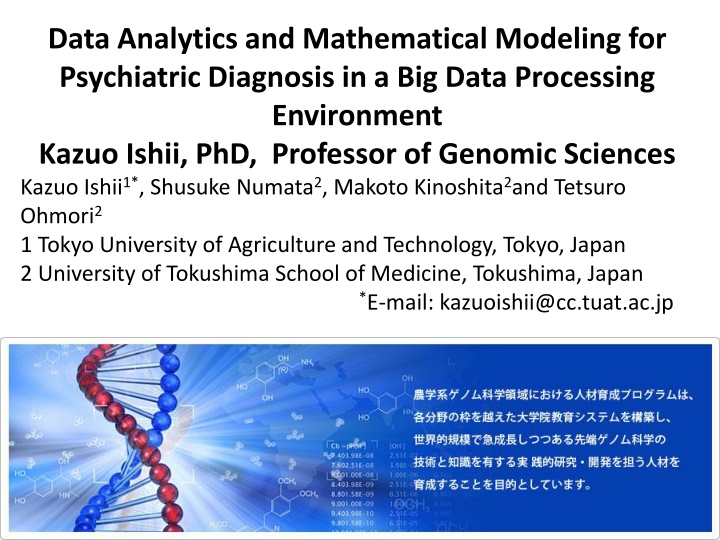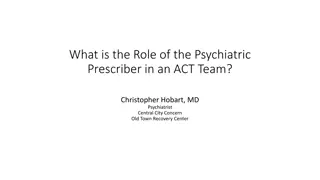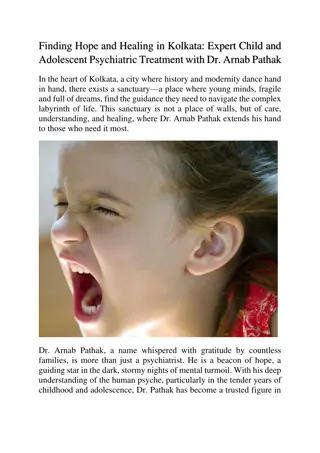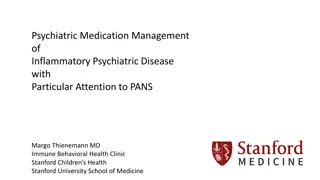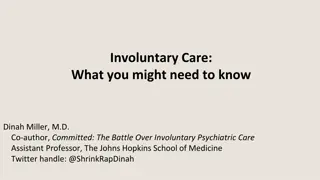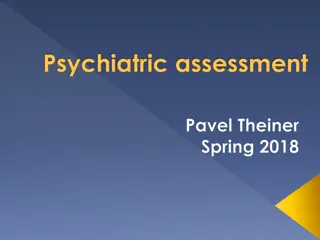Mathematical Modeling for Psychiatric Diagnosis in Big Data Environment
This research project led by Prof. Kazuo Ishii aims to develop a Big Data mining method and optimized algorithms for genomic Big Data, specifically targeting three major mental disorders including depression. The research process involves data analytics, mathematical modeling, and data processing techniques such as Hadoop MapReduce and statistical significance tests. The ultimate goal is to create a new diagnosis system for mental health disorders leveraging the power of Big Data.
Download Presentation

Please find below an Image/Link to download the presentation.
The content on the website is provided AS IS for your information and personal use only. It may not be sold, licensed, or shared on other websites without obtaining consent from the author.If you encounter any issues during the download, it is possible that the publisher has removed the file from their server.
You are allowed to download the files provided on this website for personal or commercial use, subject to the condition that they are used lawfully. All files are the property of their respective owners.
The content on the website is provided AS IS for your information and personal use only. It may not be sold, licensed, or shared on other websites without obtaining consent from the author.
E N D
Presentation Transcript
Data Analytics and Mathematical Modeling for Psychiatric Diagnosis in a Big Data Processing Environment Kazuo Ishii, PhD, Professor of Genomic Sciences Kazuo Ishii1*, Shusuke Numata2, Makoto Kinoshita2and Tetsuro Ohmori2 1 Tokyo University of Agriculture and Technology, Tokyo, Japan 2 University of Tokushima School of Medicine, Tokushima, Japan *E-mail: kazuoishii@cc.tuat.ac.jp
Agenda Back ground Research Aim and Target Research Scheme Practical Case Study Summary
Back ground Era of Genomic Big Data Genomic Big Data production by Next Generation Sequencing Technologies is increasing year after year. Next Generation Sequencers
Back ground Mental Health Neuropsychiatric Disorders, such as depression, bipolar disorders are increasing year after year. But, no effective evidence based-diagnosis. Big Data-based new diagnosis system is expected to provide revolutionary innovation in mental health. From Japanese Government Documents (2012) Increasing Number of Mental Illness (x 1000 persons) Bipolar Disorders Depression Persistent Mood Disorders Others 1996 1999 2002 2005 2008 2011
Research Aim and Target Research Aim and Target Aim: Development of Big Data Mining Method Development of optimized algorithm and mathematical modeling methods for genomic big data; from 500,000 - 10,000,000 explanatory variables (biological markers) Target (Data is provided by Tokushima Univ.) Diagnosis system for three major mental disorders; depression, etc
Overview of Research Process Mathematical Modeling for Big Data Hadoop MapReduce, shell scripting, data processing with NoSQL, Monte Carlo Simulation Research Scheme Unstructured Data Data processing with RDMS MySQL, PostgreSQL Structured Data Statistical significance tests (Student's t test, Mann-whitney U test, etc), sparse modeling Selection of Explanatory Variables Multivariable analyses (Multiple Regression, Discriminant analysis), Support Vector Machine (SVM), Machine Learning (SOM etc.), Baysean Filtering, etc. Discrimination of Data Mathematical Modeling Linear Regression Model, Logistic Regression Model and Mixed Model, etc. Coefficient of determination, Wilks Lambda, Akaike's Information Criterion (AIC), Bayesian Information Criterion (BIC), etc. Optimization of Models Evaluation of Models Cross validation, including Leave-one Out
Research Scheme HPC and Cloud (Amazon) Powerful and High Performance HPC Very Large Memory and Many Core CPUs 4TB Memory, 80 core CPU Cloud (Amazon) Many Core CPUs but memory is not so large 244 GB Memory, 32 core CPU x n More core CPUs available by using many instances. Platform should be selected based on its purpose
Research Scheme Example of Methylation Calling Software Bismark Mapping with bowtie PASH small memory and fast BSMAP Mapping with SOAP Methylcoder BS-Seq for plants Kismeth for plants, web-based
Research Scheme Platform should be selected based on its purpose Data Analysis of Methyl-Seq requires extremely large memory ex. BisMark (Methylation site calling soft) -> 870 GB in one process R -> 900 GB in one process requires about 1TB memory Amazon Cloud could not analyze methylation calling with BisMark
Practical Case Study Practical Case Study Here, we only show the case of 450K MicroArray in this presentation. Results of NGS will be shown elsewhere.
Research Process in This Method Mathematical Modeling for Big Data Illumina 450K DNA Methylation Microarray Structured Data Selection of Explanatory Variables Mann-whitney U test and Ranking Discrimination of Data Linear Discriminant Analysis (LDA) Mathematical Modeling Discriminant Function Backward Elimination Method Optimization of Models Cross validation (Training set and Validation set) Evaluation of Models
DNA Methylation rate does not show a normal distribution Beta-value for an ithinterrogated CpG site is defined as: where yi,mentyand yi,unmentyare the intensities measured by the ithmethylated and unmethylated probes, respectively Both Next Generation Sequencing Data and Methylation MicroArray Data
DNA Methylation rate does not show a normal distribution No equal variances Sites Range: 0 <= Beta <= 1 Beta Score Both Next Generation Sequencing Data and Methylation MicroArray Data Protocol Exchange (2014) doi:10.1038/protex.2014.002
Mon Parametric Test is Required Mann Whitney U test Selected Sites - Log2(P) 20 patients and 19 healthy volunteers This is the example of one neuropsychiatric diseases. 20 patients and 19 healthy volunteers were tested with 500, 000 explanatory variables.
Linear Discriminant Analysis Discriminant Function
Discriminant Function Discriminant Score where fkm= the value (score) on the canonical discriminant function for case m in the group k. Xikm= the value on discriminant variable Xi for case m in group k; and ui= coefficients which produce the desired characteristics in the function.
Evaluation of the Discrimination Sensitivity and Specificity Sensitivity = true positives / (true positive + false negative) = Diagnosed as patients / Patients Specificity = true negatives / (true negative + false positives) = Diagnosed as non patients / Healthy Volunteers
Discriminant Analysis of a Psychiatric Disorder with DNA Methylation Markers in a Training group Discriminant analysis with 20 patients and 19 healthy volunteers (Training group) With methylation rate of DNA Markers top20 ranked by Mann-whitny U test 20 patients and 19 healthy volunteers Negative Discriminant Score Positive Healthy Volunteer Patients
Discriminant Analysis of a Psychiatric Disorder with DNA Methylation Markers in a Validation group Discriminant Analysis with 12 patients and 12 healthy volunteers (Validation group) With Methylation rate of DNA Markers top20 ranked by Mann-whitny U test 12 patients and 12 healthy volunteers 12 patients and 12 healthy volunteers Discriminant Score Positive Negative Healthy Volunteer Patients The discriminant function was reconstructed for evaluation of variables.
Cluster Analysis of a Psychiatric Disorder with DNA Methylation Markers in a Training group MDD Control:13_Mathylation_Sites Patients Healthy Volunteer 20 patients and 19 healthy volunteers 6 5 4 2 1 9 8 10 13 3 11 7 12 X7512551017_R01C02.AVG_Beta X7512551017_R04C02.AVG_Beta X7512551047_R06C02.AVG_Beta X7512551017_R05C02.AVG_Beta X7512551047_R02C02.AVG_Beta X7512551047_R01C02.AVG_Beta X7512551047_R03C02.AVG_Beta X7512551047_R05C02.AVG_Beta X7512551017_R02C02.AVG_Beta X7512551047_R04C02.AVG_Beta X7512551017_R06C02.AVG_Beta X6264488085_R03C02.AVG_Beta X6264488085_R04C02.AVG_Beta X6057825132_R06C02.AVG_Beta X6264488085_R01C02.AVG_Beta X6264488085_R05C02.AVG_Beta X6057825132_R04C02.AVG_Beta X6264488085_R02C02.AVG_Beta X6264488085_R06C02.AVG_Beta X7512551017_R03C02.AVG_Beta c7512551047_R01C01.AVG_Beta c7512551047_R03C01.AVG_Beta c6264488085_R04C01.AVG_Beta c6264488085_R05C01.AVG_Beta c6264488085_R01C01.AVG_Beta c7512551017_R02C01.AVG_Beta c7512551047_R05C01.AVG_Beta c7512551047_R06C01.AVG_Beta c7512551017_R06C01.AVG_Beta c7512551017_R01C01.AVG_Beta c7512551047_R04C01.AVG_Beta c6057825132_R06C01.AVG_Beta c6264488085_R03C01.AVG_Beta c7512551017_R03C01.AVG_Beta c7512551017_R04C01.AVG_Beta c6057825132_R05C01.AVG_Beta c6264488085_R06C01.AVG_Beta c6057825132_R04C01.AVG_Beta c7512551017_R05C01.AVG_Beta
Summary Big Data processing environment should be selected based on its performance and purpose of data analysis Multivariable diagnosis methods using DNA methylation ratio works well for Diagnosis of Psychiatric Diseases Selection with a non parametric test and multivariable analysis is extremely effective
